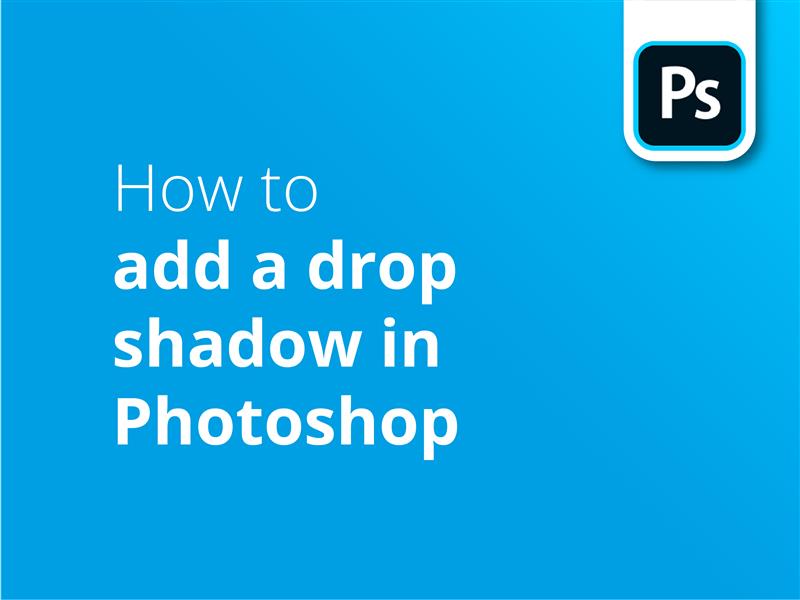There are a number of ways to add a drop shadow in Photoshop. This simple method allows you to apply an image or text shadow in Photoshop.
How to create a drop shadow in Illustrator in 7 easy steps
Use this simple step-by-step process to create your drop shadow in Adobe Photoshop:
- Position your graphic on the canvas
- Right-click on the Photoshop layer
- Select Drop Shadow from the pop-up layers palette
- Adjust attributes such as “opacity”, “distance”, “spread” and “size” using the sliders
- Set the angle of the drop shadow using the clock face style adjustment tool
- Check the “Global Light” box to apply this angle to all drop shadows within the project for a consistent look
- Use the Quality section of the pop-up window to experiment with effects the “contour” and “noise” effects.
This is a great method for beginners, but for more advanced users, our video also expands on more advanced techniques.
Video tutorial: How to add a drop shadow in Photoshop
Our graphic design tutorial videos are filled with hints and tricks like these to expand your skills. Keep up with the series by subscribing to the Solopress YouTube channel.
Video Transcription
How to add a drop shadow in Photoshop
Hello everyone,
My name’s Dan, and welcome to our tutorial on how to add a drop shadow in Photoshop. There are loads of ways to do this, but firstly I’ll show you the most basic and easy way, using the built-in tool.
First, we need to create a Photoshop document. Open Adobe Photoshop CC, click the ‘File‘ drop-down menu and select ‘New’.
A window pops up prompting you to name your new document and enter dimensions and preferences.
I’m happy with these default settings, so I’ll click ‘Create’.
Now I’ll drag and drop a graphic into my image.
I position it to where I want it and hit enter to place the object.
With the graphic selected in the Layers panel, I can head over to the bottom right-hand side of the screen, click on the small FX icon, and select Drop Shadow from the pop-up menu.
The drop shadow dialog box will pop up and give you various options that you can adjust to your liking.
In the “structure” section, various sliders adjust different attributes of the drop shadow option. Before we explore these options, I’ll just adjust the distance so that the shadow becomes visible.
As you can see, at the moment, with the distance set to 0, the shadow follows the same shape as your graphic, so I’ll just move the distance slider to the point where you can easily see your shadow
If I drag in a transparent object with a more complicated shape and add a natural drop shadow effect, only the opaque part of the image casts a shadow. We’ll take a look at adjusting this one.
Incidentally, if you’ve been using a more recent version of Adobe Photoshop with Smart Objects, don’t worry if you press OK without finishing your changes. Go back to your layers panel and simply double-click on where it says “drop shadow” and you’ll get your drop shadow’s ‘Layer Style’ window back. I’m going to add a background texture to the composition so we can see the drop shadow effect.
So, going back to adjust the attributes of the shadow itself, the first slider within the ‘Structure’ section is called ‘Opacity.’ It can adjust how solid your shadow appears against the white background. If we move the opacity slider all the way to 100%, it will basically appear like a solid object that’s completely opaque, whereas a number closer to 0% will ensure the shadow fades into the background layer.
The next things to look at are light angle and distance. We already adjusted the distance enough so that we could see the shadow, but now we can fine-tune that distance as well as rotating the shadow. Rather than a slider control, the angle adjustment is achieved by moving what looks like a hand around a clock face.
Adjusting the angle and distance has the effect of moving the light source, casting the shadow from different heights and angles. Rather than using the clock face and slider controls, you can enter numerical values in the data fields by the controls or even use the arrow tool to grab and drag the shadow around your image while the Layer Style pop-up is still open. Making a light source adjustment is one of the most effective ways of creating natural shadows in your design.
You may have noticed that near the top is a checkbox that says “Use Global Light”. This means that you can have multiple items with exactly the same drop shadow settings, and change them all at the same time as well. It’s particularly useful if you have a large composition with multiple items that you may wish to adjust in the future, so you can match all of their exact shadow values.
The next option to keep in mind is the spread, and this adjusts the feathering or blurring of the edges. When we move it to 0, it’s feathered very well, but moving it to 100%, the shadow is very sharp and solid.
Next up is size. Self-explanatory. Move the size slider to adjust the size of the shadow, which also simulates how close the light source is to the object. The lower the value, the smaller the shadow. Sometimes these drop shadow settings don’t seem to make sense, so trial and error is often the method to use when using the shadow size slider.
Below the Structure section, you have the Quality section, where you can change the contour and add noise using the noise slider. This is a settings bank which I’ve seldom ever used, as it seems to be for very niche applications.
So that’s the most basic drop shadow technique. But whilst the built-in tool is brilliant for basic use, a graphic designer would prefer to create manual drop shadows that can be manipulated perfectly, so another way to add a realistic drop shadow in Photoshop is via the duplication method.
The Duplication Method
Rather than relying on the Adobe Photoshop drop shadow tool, this method creates an additional layer that duplicates your original graphic and uses that as the basis for your shadow. allowing greater scope for editing and manipulation.
We’ll start off with some basic text by pressing the Text Layer button, clicking on the comp and typing out what we’d like. To make it easier to distinguish, I’ll give this layer a red gradient, and press the enter key on the right-hand side of the keyboard to commit changes. Next, I’ll click on the layer and Alt drag it below, or Option drag it if you’re on a mac, or alternatively Ctrl or Command J. I’ll then change the text for the duplicated layer to black, and you’ll see that when we hide the top layer using the eye icon, the layer behind is revealed.
If you’re creating a duplicate of a coloured graphic to serve as its own shadow, you’ll need to make the duplicate flat black before you start manipulating it to make it resemble a shadow. You do this by right-clicking on the duplicate layer in the Layers panel, and selecting Blending options. Check the Colour Overlay tick box and select black as the overlay colour.
We’ll rename the bottom layer our “shadow” layer so it doesn’t get confusing. With our drop shadow layer selected, we’ll press Ctrl or Command T. That brings up the blue control box around the layer that allows you to move it using the directional keys. As you can see, it moves pretty slowly, so you can also hold the shift button to make the movements larger.
Now we’re in a position to manipulate the shadow however we want, so find a suitable place and anchor the object by pressing the enter button. It looks quite good the way it is right now, but further editing may be required for the shadow to appear authentic in context.
By going to the filter menu at the top, we’ll go to Blur, and the Gaussian Blur, and this little window pops up. This type layer must be rasterized or converted to a smart object before proceeding. If rasterized, its text will no longer be available to edit. It’s always best to convert to a smart object, and I’ll explain why in another video, but right now we’re going to focus on blurring the layer.
So as you can see, the background layer has less harsh edges now, and we can adjust this to as sharp or as soft as we want by adjusting the radius slider in the Gaussian Blur pop-up. But, going too far makes the shadow look distorted or too generalised, so it’s usually best to keep the radius at a sensible level.
We’ll press Okay to add a change filter, which has appeared on the layer, and you can simply double-click to go back onto the option. Had we rasterized the layer, we wouldn’t be able to add a smart filter, it would just commit a layer filter forever.
Another handy advantage of having the shadow as a smart layer is that we can continue to tweak the perspective. By enabling the layer controls for the drop shadow layer as we did earlier, by selecting it in the Layers palette and pressing Ctrl or Command T, we can hold the Ctrl or Command keys whilst we warp whichever corner we want. Smart filters will be turned off temporarily, so don’t worry if our lovely blur disappears while we adjust the perspective. It actually helps us out at this point as we can be more accurate with the placement of the shadow’s base.
I want to make it look like the shadow is coming directly off of the text, so I’ll stretch it out a little bit further than the height of the text, press enter as we did earlier, and then disable the blur using the eye icon. It still doesn’t look right, and that’s because we moved the drop shadow layer earlier when it was a 2D-style shadow. We can now move it back manually using the directional keys and now it looks great. And there you have it, two easy ways to create a drop shadow in Photoshop.
If you enjoyed this drop shadow Photoshop tutorial, please leave a like, and if you have any questions or suggestions, please feel free to comment on them. We’re creating all kinds of tutorials for Adobe programs, so hit subscribe and enjoy our content.
How to use drop shadows in print
Here are some examples of how adding drop shadows in Photoshop can be used when creating print-ready artwork:
- Add Depth and Dimension: Drop shadows can be added to text, logos, or images to create a sense of depth and dimension, making these elements appear as if they are floating above the background. This effect helps grab the viewer’s attention and can make the design more visually appealing.
- Visual Hierarchy: Using drop shadows in Photoshop strategically can help to establish a visual hierarchy in graphic design. For instance, adding a subtle drop shadow to the main heading or a company logo on a brochure or leaflet can emphasise its importance and draw the reader’s eye to that particular element.
- Contrast Enhancement: Drop shadows can be utilised to enhance the contrast between an object and its background, particularly if the background is busy or has a similar colour to the object. This technique can improve readability and ensure that key information, such as contact details on a Business Card, stands out.
- Layering Effect: In complex designs featuring multiple elements, drop shadows can be employed to create a layering effect, giving the impression that certain elements are overlapping others. This can add visual interest and create a dynamic, modern look in printed materials such as Flyers.
- Framing and Highlighting: Applying drop shadows around the edges of an image or a text box can act as a subtle frame, drawing attention to the content and highlighting its importance. This technique works well in Booklets where specific sections or offers need to be emphasised.
- Textured Backgrounds: Drop shadows can also be used creatively to generate textured backgrounds. By adding a shadow to a pattern or shape and repeating it across the background, you can create an engaging, eye-catching backdrop.
By incorporating realistic shadows into your designs, you can enhance the visual appeal and effectiveness of print-ready artwork for various products, ensuring your designs stand out and communicate effectively.




